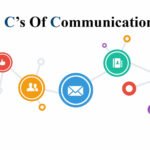The Types of Communication: A Comprehensive Guide to Different Communication Methods

Communication is a fundamental aspect of human interaction, allowing us to connect, understand, and convey our thoughts and ideas.
In today's fast-paced world, it is crucial to have a comprehensive understanding of the various communication methods available to us. From verbal communication, which involves the use of spoken words, to non-verbal communication, which encompasses body language and facial expressions, each method plays a unique role in effectively conveying messages.
In this article, we will explore the different types of communication methods, including written communication, listening, and visual communication.
By delving into these techniques, we hope to provide you with a comprehensive guide to navigate and excel in various communication scenarios.
So, whether you are looking to improve your public speaking skills, enhance your writing abilities, or master the art of active listening, this guide has got you covered. Let's dive in and unlock the secrets of effective communication.
Verbal Communication
Verbal interaction is a basic element of human communication. Expressing messages, ideas, and emotions through spoken words and language is a vital aspect of our lives, whether it be in personal connections, professional contexts, or social gatherings.
Through verbal communication, we can articulate our thoughts, disseminate information, carry on meaningful dialogues, and form ties with others.
It allows us to communicate our objectives, clarify misunderstandings, and broker agreements.
Competent verbal communication is not only about the words utilized, but also about the tone, pitch, and delivery of our address. It is an influential tool that allows us to connect and comprehend one another more profoundly.
In the domain of verbal communication, numerous factors contribute to effective and efficient discourse. One of these is active listening. Communication is a two-way process, and listening is fundamental to guaranteeing that the message is heard and comprehended accurately.
Active listening includes giving our undivided attention to the speaker, focusing on their words, and striving to understand their message thoroughly. It entails not only hearing the words being said but also being aware of the speaker's tone, emotions, and non-verbal cues.
By actively listening, we can avoid misconstruing, show respect for the speaker, and cultivate a deeper level of understanding and affiliation.
Communication is also about the ability to adjust our language and style to different situations and audiences. Skilled communicators appreciate the importance of customizing their message to suit the needs and preferences of the listener.
This involves considering factors such as the level of familiarity, cultural background, and language aptitude of the audience. By adapting our communication style, we can make sure our message is clear, relatable, and easy to comprehend.
It also facilitates building rapport and trust with others, as they feel heard and appreciated.
Thus, communication is a dynamic and potent tool that allows us to articulate ourselves, relate to others, and manage the intricacies of human interaction.
By improving our verbal communication skills, we can upgrade our relationships, further our careers, and promote a more harmonious and understanding society.
Non-Verbal Communication
Non-verbal communication plays a crucial role in our daily interactions, extending beyond spoken words and encompassing various forms of expression that augment our mutual understanding. Body language is a powerful tool that can convey emotions, intentions, and attitudes without needing to utter a single word.
Facial expressions are a prime example of this, allowing us to readily gauge the emotional state of our conversational partner. Establishing eye contact is another essential non-verbal cue that builds trust and engagement.
By being aware of these non-verbal signals, we can better comprehend the messages being conveyed, thus improving our overall communication skills.
Appearance also plays an important role in non-verbal communication. How we present ourselves, such as our clothing and grooming, can communicate messages about our personality, professionalism, and social status.
Visual cues can greatly influence how others perceive us, and shape their initial impressions. It is therefore essential to recognize the power of appearance in communication.
Sign language is yet another form of non-verbal communication, which is especially important for those with hearing impairments. It is an intricate system composed of hand movements, gestures, and facial expressions that allows deaf individuals to effectively communicate.
Sign language is not just a means of conveying information, but also a highly expressive language with its grammar and syntax.
Knowing and using sign language is essential for inclusive communication and ensuring equal access for all.
Non-verbal communication is a captivating field of human interaction, encompassing a wide range of cues and signals that contribute to successful communication.
By being conscious of these non-verbal cues, we can enhance our understanding of others, and improve our communication skills, allowing us to create stronger connections.
From body language to facial expressions, eye contact, appearance, and sign language, non-verbal cues add additional layers of meaning to our conversations, and can significantly influence the effectiveness of our verbal communication.
Written Communication
Communication through the written word is a ubiquitous part of today's digital society and is a skill that is essential in both personal and professional settings. It allows expressing thoughts and ideas with clarity and accuracy, providing a permanent record that can be referred back to.
Utilizing technology, correspondence can occur quickly and easily, yet written communication remains a paramount method of conveying information.
To ensure effective written communication, detail, precision, and an understanding of the recipient are paramount. Utilizing the proper words, grammar, and punctuation will ensure the message is received as it was intended.
Furthermore, written communication allows for editing and proofreading, allowing you to review and amend your message before sending it out. This guarantees a professional and organized presentation.
Moreover, written communication provides a level of formality and structure not present in verbal communication, enabling the creator to present a cohesive argument or perspective.
Whether producing a persuasive essay, a business proposal, or a simple text message, written communication is essential to effectively convey information and ideas to others.
If you are unable to communicate verbally, written communication is an invaluable tool for successful communication.
Listening
Listening is a crucial part of successful communication. It necessitates paying attention to the speaker and grasping the message being conveyed.
Active listening necessitates concentration and focus, as well as the capability to interpret and comprehend the information being shared.
By engaging actively in the listening process, individuals can gain a deeper understanding of the speaker's standpoint and effectively answer their needs or worries.
In both personal and professional situations, the skill of listening is imperative for creating solid relationships and promoting efficient communication.
Competent listening goes beyond simply hearing the words being spoken.
It necessitates being present in the moment and giving the speaker your undivided attention.
This implies avoiding distractions, such as checking your phone or pondering what you're going to say next.
By totally immersing yourself in the conversation, you can detect subtle signals and non-verbal communication that can improve your comprehension of the message. Besides, active listening necessitates asking clarifying questions and summarizing what you've heard to guarantee precise comprehension.
This not only demonstrates to the speaker that you are engaged but also helps to avoid misconceptions.
Listening is not only about listening to the words but also understanding the fundamental emotions and intentions behind them. This requires sympathy and the capacity to place yourself in the speaker's position.
By listening with empathy, you can acquire a superior comprehension of the speaker's viewpoint and answer in a way that is supportive and compassionate. This is significantly significant in situations where individuals may be expressing their feelings or worries.
By listening with empathy, you can confirm their encounters and provide the assistance they need.
Constructing good listening abilities is an ongoing procedure that necessitates practice and self-awareness. It involves being conscious of your own biases and judgments that may obstruct your capacity to truly listen. By actively working on enhancing your listening skills, you can enhance your communication skills and build firmer connections with others.
Bear in mind, that listening is not just about hearing the words; it's about understanding and answering in a way that promotes effective communication.
By making an intentional effort to be an active listener, you can significantly enhance your relationships and overall communication skills.
Visual Communication
Visual communication is a compelling way of expressing ideas without words.
It utilizes images, illustrations, colors, and other visual elements to transfer emotions, knowledge, and information.
In today's digital world, visual communication has become ever more relevant, as people are exposed to visual stimuli each day.
From advertising and social media posts to infographics and video presentations, visual communication is integral in catching attention and delivering messages efficiently.
Its straightforwardness and eye-catching visuals make it an excellent tool for conveying complex topics in an understandable and visually pleasing manner.
Visual communication offers an array of approaches to engage and advise audiences in multiple contexts, making it a crucial part of communication. This can include photographs, drawings, diagrams, charts, or videos.
Visual communication is especially helpful in cases where language can be a barrier.
It surpasses cultural and language divides, allowing individuals of different backgrounds to interpret and understand visual messages.
As an example, in international airports, images and symbols are habitually used to indicate the direction of passengers or to present important information.
Additionally, in education, visual resources such as diagrams, charts, and graphs are used to better learning and comprehension.
Moreover, visual communication can be utilized in marketing and advertising to generate visually attractive and unforgettable campaigns.
Furthermore, it can be an invaluable aid for storytelling, as it can stir emotions and establish a connection with the audience.
In conclusion, visual communication is a vibrant and engaging method of communication that increases the overall effectiveness and impact of messages in varied conditions.
Leave a Reply




Related Posts